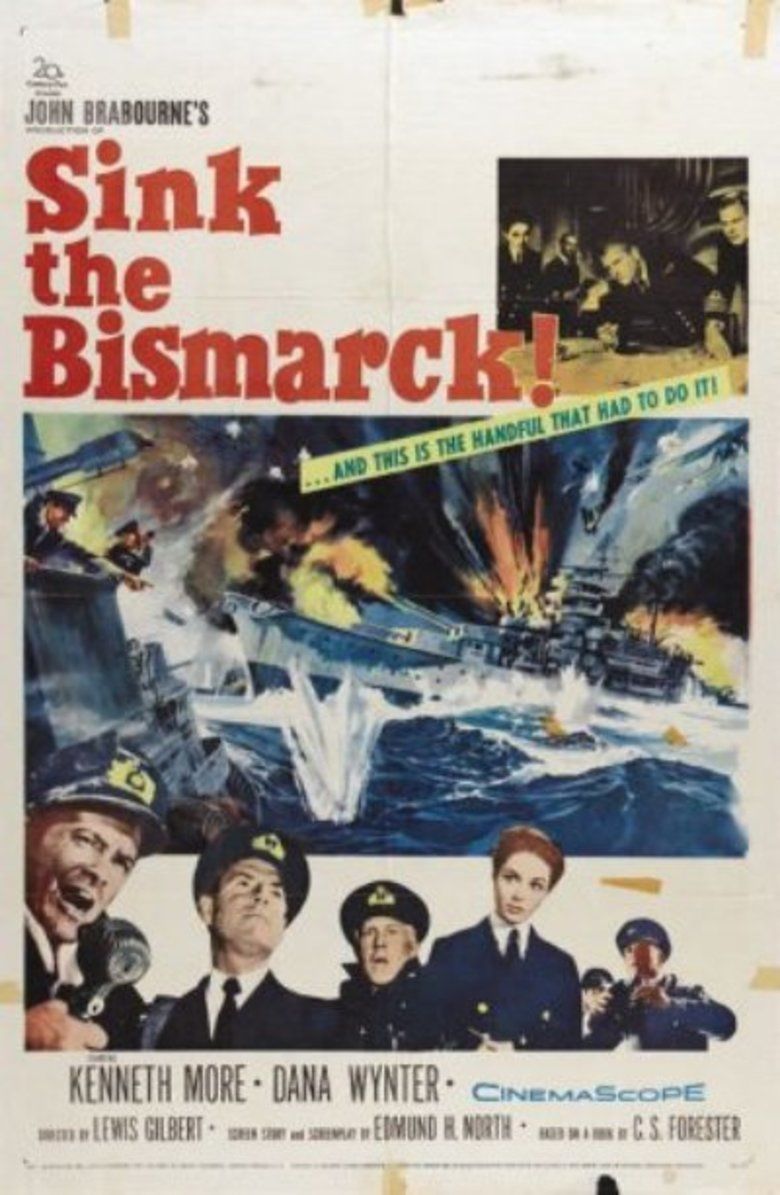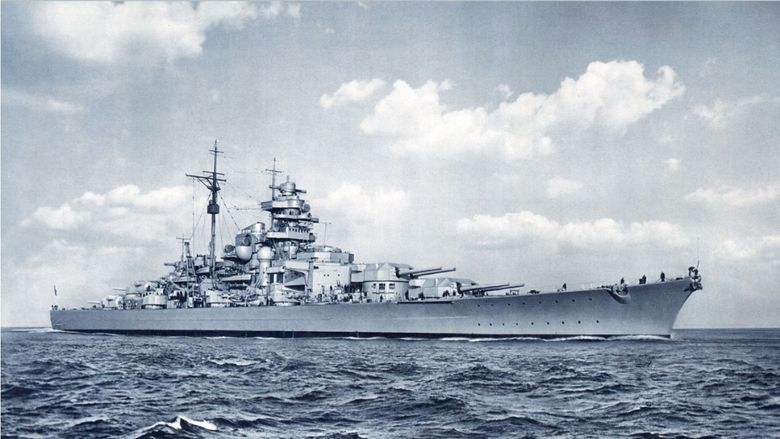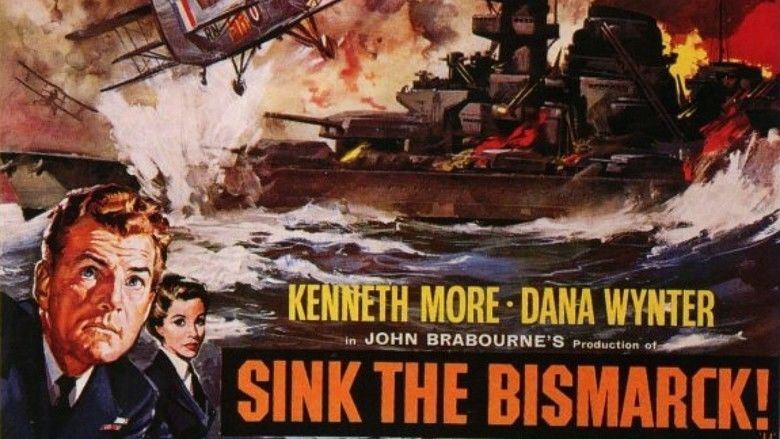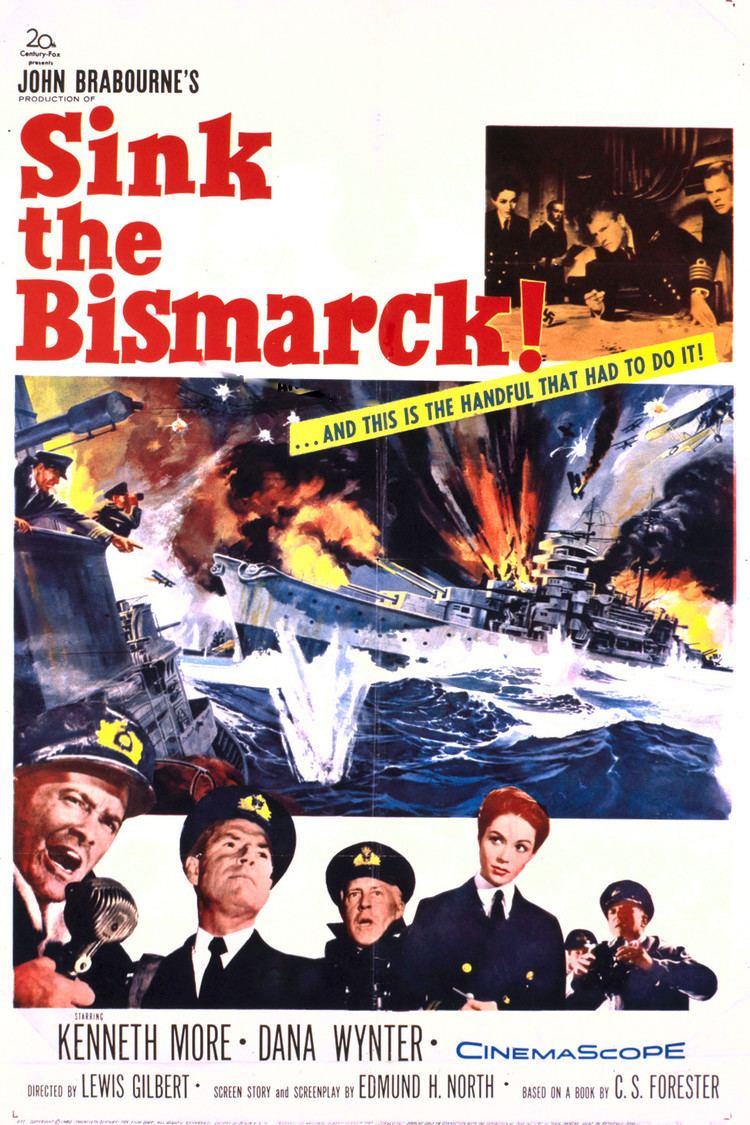Sink the Bismarck!
7.2 /10 1 Votes7.2
Initial DVD release May 20, 2003 Duration Language English | 7.2/10 IMDb Genre Action, Drama, History Country United Kingdom | |||||||||||||||||||||||||||||||||
 | ||||||||||||||||||||||||||||||||||
Release date 11 February 1960 Based on Last Nine Days of the Bismarck1958 novel by C. S. Forester Cast (Captain Shepard), (Anne Davis), (Captain Lindemann), (First Sea Lord), (A.C.N.S.), Karel Stepanek (Admiral Lutjens)Similar movies Gift Horse (1952), Submarine X-1 (1969), The Cruel Sea (1953), We Dive at Dawn (1943), The Cockleshell Heroes (1955) | ||||||||||||||||||||||||||||||||||
Sink the Bismarck! is a 1960 black-and-white CinemaScope British war film based on the book The Last Nine Days of the Bismarck by C. S. Forester. It stars Kenneth More and Dana Wynter and was directed by Lewis Gilbert. To date, it is the only film made that deals directly with the operations, chase and sinking of the battleship Bismarck by the Royal Navy during the Second World War. Although war films were common in the 1960s, Sink the Bismarck! was seen as something of an anomaly, with much of its time devoted to the "unsung back-room planners as much as on the combatants themselves." Its historical accuracy, in particular, met with much praise despite a number of inconsistencies.
Contents
- Plot
- Ashore
- At sea
- Production
- Ships involved
- Historical accuracy
- Portrayal of Gnther Ltjens
- Critical
- Box office
- Other productions
- References

Sink the Bismarck! was the inspiration for Johnny Horton's popular 1960 song, "Sink the Bismarck." The film had its Royal World Premiere in the presence of the Duke of Edinburgh at the Odeon Leicester Square on 11 February 1960.

Plot

The story starts with a clip of actual German newsreel footage from 14 February 1939, when Nazi Germany's largest and most powerful battleship, Bismarck, is launched in a ceremony at Hamburg with Adolf Hitler in attendance. The launching of the hull is seen as the beginning of a new era of German sea power.
Two years later, in 1941, British convoys are being ravaged by U-boats and surface raider attacks that cut off supplies essential for Britain's abilities to continue the war. In May, British intelligence discovers the Bismarck and the heavy cruiser Prinz Eugen are about to break out of the Baltic and into the North Atlantic to attack convoys.
Meanwhile, a spy in Norway spots the Bismarck and its escort Prinz Eugen at anchor in Grimstadfjord, while perched on a ledge overlooking them; he attempts to alert the Admiralty by telegraph but he is discovered by a German guard and his German Shepherd and gets fatally shot. The spy, still alive, attempts to message the Admiralty. He is only able to message that one of the ships is Prinz Eugen but is killed before he can complete the message saying that the second ship was the Bismarck.
The man assigned to coordinate the hunt is the Admiralty's chief of operations, Captain Jonathan Shepard (Kenneth More), who has been distraught over the death of his wife in an air raid and the sinking of his ship by the German battleships Scharnhorst and Gneisenau, commanded by Fleet Admiral Günther Lütjens (Karel Štěpánek). Upon receiving his new post, Shepard discovers Lütjens is the fleet commander on the Bismarck. Shepard's experience of conflict with Nazi Germany's Kriegsmarine and his understanding of Lütjens allow him to predict the Bismarck's movements. Shepard acts coldly to his staff but comes increasingly to rely on the coolness and skill of his assistant, WRNS Second Officer Anne Davis (Dana Wynter).
Lütjens is also bitter. After the First World War, he considered that he had received no recognition for his efforts in the war. Lütjens promises the captain of the Bismarck, Ernst Lindemann (Carl Möhner), that this time, he and Germany will be remembered as the victors.
Next morning near the Denmark Strait Bismarck and Prinz Eugen encounter HMS Hood and HMS Prince of Wales. The four warships engage in a heavy battle. During the battle a shell from Bismarck hits the Hood slightly damaging her. Bismarck fires another salvo from her main battery guns and both sides watch as three shells hit the water near the Hood, but the fourth hits it just below its mast and a penetrating the thin deck armour above the magazines; suddenly the ship's deck simultaneously disintegrates and explodes in a massive fireball, even blowing the turrets off and sending them flying into the ocean. Both sides are shocked and horrified at the devastation as the Hood's sinking remains are enveloped by smoke. The captain of the Prince of Wales, John Leach asks the yeoman to send a message to Admiralty saying that the Hood has catastrophically sunk. Now Prince of Wales is alone and gets fired at by the two German ships and is severely damaged. The ship makes smoke and retreats. The Bismarck's escape is shadowed by smaller British ships. Meanwhile, Shepard, obsessed with Bismarck, acknowledges that his son, an air-gunner on a Fairey Swordfish torpedo bomber from HMS Ark Royal, one of the British ships deployed to the hunt, may die when the British aircraft attack the Bismarck. He gambles that Lütjens is returning to friendly waters where U-boats and air cover will make it impossible to attack, and plans to intercept and attack "Bismarck" before it reaches safety.
Shepard commits large forces stripped from convoy escort and uses Catalina flying boats to search for the battleship. His hunch proves correct, and Bismarck is located, apparently steaming towards the German-occupied French coast. British forces have a narrow window to destroy or slow their prey before German support and their own diminishing fuel supplies prevent further attack, as Admiral Lutjens says to Captain Lindemann. Swordfish aircraft from HMS Ark Royal have two chances. The first fails: they misidentify HMS Sheffield as Bismarck; also the new magnetic torpedo detonators are faulty and most explode as soon as they hit the water. Switching to conventional contact detonators, the second attack is successful, with one torpedo hitting the midships, causing minor damage, while a catastrophic second hit detonates near the stern, causing extensive damage jamming Bismarck's rudder and slowing her speed to 25 knots.
Unable to repair the rudder, the German battleship steams in circles. During the night Bismarck is attacked by two British destroyers. They fire torpedoes at Bismarck, and one torpedo hits the battleship, but Bismarck returns fire, sinking the destroyer HMS Solent. The main force of British ships (including battleships HMS Rodney and HMS King George V) find Bismarck the next day and rain gunfire on her. Lütjens in his final moments insists to Lindemann that German forces will arrive to save them, but he dies when a shell destroys Bismarck's bridge. After that, the remaining officers declare "Abandon Ship!" In the King George V Admiral Tovey orders the newly joined cruiser HMS Dorsetshire to finish Bismarck off with torpedoes. The cruiser fires a salvo of six torpedoes at the already sinking and severely damaged vessel. Four torpedoes strike the hull, causing the ship to list faster than the men can get out. The Captain in King George V lowers his head as the Bismarck rolls over and sinks beneath the waves. The Admiral orders Dorsetshire to pick up the remaining survivors, and finally says tersely: "Well gentlemen, let's go home."
After the sinking of the Bismarck, and having been told that his son has been rescued, Shepard asks Davis out for dinner, believing it to be nine o'clock at night, only to realise it is nine in the morning after stepping outside and seeing the sky. Davis suggests breakfast instead, and they walk off together, just as the film ends.
Ashore
and
At sea
Production
C. S. Forester reportedly wrote the story as a screen treatment for 20th Century Fox before even writing the book.
Writer Edmund H. North worked closely with Forester's story, compressing events and time lines to make the plot taut. Along with the director, he decided to use a documentary-style technique, switching back-and-forth from a fairly insular war room to action taking place on remote battleships. The action is made more realistic when the human element of men in a game of wits and nerves is involved. The use of Edward R. Murrow reprising his wartime broadcasts from London also lends an air of authenticity and near-documentary feel. The film credits identify the actual Director of Operations as Capt. R. A. B. Edwards and "Capt. Shepard" as fictional. The Shepard-Davis interplay added human interest to the storyline.
In a similar manner, the battle between British and German forces is also recreated as a human drama, with Admiral Lütjens pitted against Capt. Shepard in a "psychological chess match."
Ships involved
Sink the Bismarck! was made in 1960, as the last major Second World War fleet units were being retired. Producer John Brabourne was able to use his influence as son-in-law of Lord Mountbatten, then Chief of the Defence Staff, to obtain the full co-operation of the Admiralty. The soon-to-be-scrapped battleship HMS Vanguard provided some remarkable footage of a capital ship's 15" gun turrets in action, and was used for scenes set on board HMS Hood, Prince of Wales, King George V and the Bismarck herself. The cruiser HMS Belfast, now preserved in London, was used to depict HMS Suffolk and HMS Sheffield, two of the cruisers involved in Bismarck's pursuit. A Dido-class cruiser in reserve was used as the set for Bismarck's destruction, and one of her tall raked funnels is glimpsed in the final scenes.
The aircraft carrier HMS Victorious is briefly shown as herself, despite the postwar addition of a large angled flight deck and a massive Type 984 "searchlight" radar; the same ship is also used to depict HMS Ark Royal sailing from Gibraltar. All flying from both carriers was filmed aboard HMS Centaur – clearly marked with her postwar pennant number R06 – and three surviving Fairey Swordfish aircraft were restored, of which two were flown from her flight deck. These three aircraft now form the core of the Royal Navy Historic Flight. A 2010 article in Aeroplane identifies the Swordfish flown in the production: LS326, carrying its true serial, was marked as "5A" of 825 Naval Air Squadron, while NF389 was marked as LS423 / "5B". The same actor plays the leader of the Swordfish attack from HMS Victorious (in reality, Lt Cdr Eugene Esmonde VC, DSO), and also the HMS Ark Royal pilot who later fired the torpedo which crippled Bismarck's steering gear (since identified as Lt John Moffat RNR).
The destroyers used to depict the torpedo night attacks were the C class HMS Cavalier (D73), representing the flagship of "Captain (D), of the 4th Destroyer Flotilla", (in reality, Captain Vian in HMS Cossack) and the Battle-class destroyer HMS Hogue (D74), representing the fictitious HMS Solent which Bismarck destroys in the film. Their pennant numbers can be made out quite clearly, although they are reversed because of the film's convention that British ships should move from left to right of the screen and German ships vice versa. These were the last classes of destroyer built during the war, and the last to have the classic War Emergency Programme destroyers' outline. HMS Cavalier remained in service until 1972, the last RN destroyer to have served in the Second World War, and is now preserved at Chatham Dockyard to commemorate all these vessels, but the newer and larger HMS Hogue was broken up shortly after the film was completed, following a collision off Ceylon with the Indian cruiser INS Mysore (formerly HMS Nigeria).
The large models of the major warships: Bismarck, HMS Hood, HMS Prince of Wales, HMS King George V, HMS Rodney and the County-class cruisers, are generally accurate, although HMS Hood is depicted in a slightly earlier configuration than that which actually blew up. The use of models in a studio tank was intercut with wartime footage and staged sequences using available full-size warships. Bismarck's anti-aircraft guns, however, are represented by stock footage of British QF 2-pounder naval guns.
Historical accuracy
Sink the Bismarck! was made before 1975, when the British code-breaking at Bletchley Park was declassified, so it did not reveal that Shepard's hunches about the movements of the Bismarck were supported by intelligence. Direction finding and traffic analysis showed that on 25 May, the Bismarck stopped talking to Wilhelmshaven and started up with Paris, and Shepard committed to the belief that the Bismarck was headed for the French coast. The radio switch from Wilhelmshaven to Paris might have been caused by the Bismarck's crossing the line southern Greenland - northern Hebrides which brought her under Group West instead of Group North. Nonetheless, Shepard's hunch was soon proved correct when, by good luck, a Luftwaffe Enigma transmission was intercepted and decoded at Bletchley Park, revealing that the Bismarck was headed for Brest to repair an oil leak. The Luftwaffe Enigma code had been broken early in the war, unlike the German naval Enigma, which was only broken later and was subject only to traffic analysis during the Bismarck affair. Damage during its battle with HMS Hood and HMS Prince of Wales caused flooding that put the Bismarck's bow barely above sea level, and oil slicks caused by hits from HMS Prince of Wales were apparent; in the film, the Bismarck's bow remains at its normal height above sea level.
Some minor continuity errors involve the visual appearance of the Bismarck. When a spy in Kristiansand, Norway, sees the Bismarck arrive in Norwegian waters (sailing from the east), the ship is shown sailing from right to left (from the west). The Bismarck has no apparent camouflage but in fact, the ship still had striped "Baltic camouflage" along her sides, which was removed shortly before she headed out to sea. Also, the photo-reconnaissance Spitfire that photographs the Bismarck and Prinz Eugen in a fjord, is shown as two different versions with different canopies.
Sink the Bismarck! simplifies the movements of HMS Hood and HMS Prince of Wales in the battle. The film shows an early order to turn to allow the British ships to fire full broadsides. In reality, they sought to close the distance first, presenting smaller targets to the German ships but using only their forward gun turrets which reduced their firepower advantage by eight big guns, while the Bismarck and Prinz Eugen were firing full broadsides of all their main guns. The film does not show that HMS Hood mistook heavy cruiser Prinz Eugen for the Bismarck at first firing at the wrong ship before correcting fire. Only in its final moments did HMS Hood begin a turn to fire broadside on the Bismarck. The Bismarck hit HMS Hood during the turn and she exploded. The turn presented Hood's deck armour at an angle more vulnerable to penetration and has been cited as a possible cause for her explosion, an issue the film does not cover. HMS Hood is shown firing to port while the Bismarck is shown firing to starboard; in fact it was the other way around.
In one scene, Lütjens speculates that after the Bismarck has undergone repair in Brest, the two German battleships based there, Gneisenau and Scharnhorst, could join the Bismarck in raiding Allied shipping. There is no record of such a discussion at that time, although it would have been possible for the Bismarck to sortie with the two battleships if the Bismarck had reached the port.
Another historical error was made in depicting the night engagement between British destroyers and the Bismarck. The film portrayal shows three British hits by torpedoes, while the British destroyer HMS Solent is hit and destroyed by the Bismarck. There was no destroyer named "Solent" and no successful torpedo attack, although S class submarine HMS Solent did exist during the war as a submarine operating in the Eastern Fleet in 1944. On 26 May, a Royal Navy destroyer squadron, led by Captain (later Admiral) Philip Vian in HMS Cossack, did exchange gunfire during unsuccessful torpedo attacks, with the Bismarck inflicting minor damage to the destroyers. The heroic action of the attached Polish destroyer Piorun (ex N-class HMS Nerissa) was not depicted, although she sailed straight for the Bismarck, signalling "I am a Pole" as she went, but none of her shots found their mark.
The aircraft that finally located the Bismarck after she escaped detection by HMS Suffolk and HMS Norfolk is correctly shown as a Catalina, but the fact that it was piloted by an American Naval Reserve officer, Ensign Leonard Smith, could not be revealed until long after the war, since the United States was neutral at the time of the engagement. The attacks by Fleet Air Arm Swordfish show some aircraft being shot down: no Swordfish was lost to the Bismarck's guns and all were recovered. However, from HMS Victorious's air raid, two Fairey Fulmar escort fighters ran out of fuel and ditched. Three fliers were picked up from a rubber boat.
Sink the Bismarck! also does not show controversial events after the Bismarck sank, including HMS Dorsetshire's quick departure after rescuing only 110 survivors, because the ship suspected that a German U-boat was in the area and withdrew.
Portrayal of Günther Lütjens
The film has been criticised for its portrayal of German Admiral Günther Lütjens, who is portrayed as a stereotypical Nazi, committed to Nazism and crazed in his undaunted belief that the Bismarck is unsinkable. In reality, Lütjens did not agree with Nazi policies; along with two other navy commanders, he had publicly protested against the brutality of anti-Semitic crimes during Kristallnacht. He was one of the few officers who refused to give the Nazi salute when Hitler visited Bismarck before its first and final mission, deliberately using instead the traditional naval salute. He was pessimistic of the chances of success of Bismarck's mission and realised that it would be a daunting task. The film shows Lütjens ordering Captain Ernst Lindemann to open fire on HMS Hood and HMS Prince of Wales. In reality, Lütjens ordered Lindemann to avoid engaging HMS Hood; Lindemann refused and ordered the ship's guns to open fire.
Critical
For the most part, the historical accuracy in Sink the Bismarck! was praised by critics, with Variety calling it a "first-rate film re-creation of a thrilling historical event." A contemporary The New York Times review by A. H. Weiler, likewise championed its realism in saying "a viewer could not ask for greater authenticity." However, it went on to criticise both the acting and the constant scene changes "from Admiralty plotting rooms to the bridges of the ships at sea," claiming that this lessened the "over-all effectiveness" of both scenes. Film4 praised its cinematography, noting that it "very realistically re-enacted scenes in the War Room of the Admiralty" as well as "excellently filmed episodes using miniature models."
During the postwar period, war films were one staple of the British film industry, with Sink the Bismarck! an exemplar, sharing the "common themes, actors ... visual style and ideological messages ..." of the genre. British magazine Radio Times viewed Sink the Bismarck! positively, stating that "this fine film fully captures the tensions, dangers and complexities of battle by concentrating on the unsung back-room planners as much as on the combatants themselves" while also praising More's performance. Attention was drawn to the ways in which it deviated from other war films of the period, specifically commenting on how "there is a respect for the enemy that is missing in many previous flag-wavers". The film was given a four-star rating.
Gilbert's continual forays into events that shaped the British war experience mirrored his own background as a wartime filmmaker. His films merged historical episodes and the role of the individual, with Sink the Bismarck! characterised as having an "emotional punch, not least because Gilbert's direction relentlessly focuses on the human dimension amidst the history."
Box office
Sink the Bismarck! was well received by the public and, according to box office receipts, it was the seventh most popular film released in Great Britain in 1960. The film replicated the success of other British war-themed productions in the decade that also received healthy box office, including The Cruel Sea (1953), The Dam Busters (1955) and Reach for the Sky (1956). Unlike most British war films, however, Sink the Bismarck! was a surprise hit in North America, as well.
Other productions
A revival of interest in the Bismarck was reflected in numerous publications that followed the film, as well as a variety of scale models that were produced. When the 1989 expedition by Dr. Robert Ballard to locate and photograph the remains of the battleship proved to be successful, further attention was directed to the story of the Bismarck. A number of documentaries have also been produced including the Channel 4 miniseries Battle of Hood and Bismarck (2002) and Hunt for the Bismarck aired in 2007 on the History Channel network worldwide.
References
Sink the Bismarck! WikipediaSink the Bismarck! IMDb Sink the Bismarck! themoviedb.org
